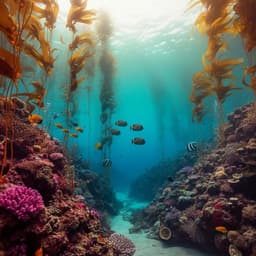
Environmental Studies and Forestry
Next-generation ensemble projections reveal higher climate risks for marine ecosystems
D. P. Tittensor, C. Novaglio, et al.
Discover the alarming findings of a new study conducted by esteemed researchers, including Derek P. Tittensor and Camilla Novaglio, which reveals that climate change is precipitating significant, long-term declines in global marine animal biomass. Utilizing enhanced marine ecosystem models, the research underscores the urgency to address uncertainties in marine ecosystem responses to climate change to aid adaptation planning.
~3 min • Beginner • English
Introduction
The study investigates how next-generation climate forcings from CMIP6 affect projections of marine ecosystem change relative to CMIP5. Anthropogenic climate change threatens marine ecosystems by altering mortality, calcification, species distributions, interactions, and biomass, and interacts with other stressors such as overfishing. Model intercomparison projects provide ensemble projections to quantify uncertainty and advance models. Fish-MIP has previously used CMIP5 Earth system model (ESM) outputs to project global and regional changes and socioeconomic implications. Here, the authors compare marine ecosystem model (MEM) ensembles driven by CMIP5 versus CMIP6 variants of two ESMs (GFDL and IPSL), under strong-mitigation and high-emissions scenarios, focusing on total unfished marine animal biomass and on temperature and productivity as key drivers. The research aims to determine whether CMIP6 forcings imply different magnitudes and spatial patterns of change and to assess mitigation benefits.
Literature Review
The paper situates its work within the context of prior Fish-MIP and CMIP research. CMIP6 provides updated oceanographic drivers with improved marine biogeochemistry, sea ice, reduced biases in nutrients, and improved surface temperature and chlorophyll skill relative to CMIP5, but with higher climate sensitivity and diverse responses in net primary production (NPP). Previous Fish-MIP studies (using CMIP5) projected global biomass declines with evidence of trophic amplification and explored basin-scale and regional impacts and socioeconomic consequences. The literature highlights uncertainties in projecting marine ecosystem responses due to differences among ESMs (e.g., NPP, export), parameterizations (e.g., remineralization temperature sensitivity), and structural differences across MEMs, as well as the potential interactions between climate change and fishing. This study addresses these gaps by updating to CMIP6 forcings and expanding the MEM ensemble.
Methodology
The authors follow the Fish-MIP ensemble protocol. Monthly ocean physical and biogeochemical outputs from two ESMs were used: CMIP5 GFDL-ESM2M and IPSL-CM5A-LR; CMIP6 GFDL-ESM4 and IPSL-CM6A-LR. Scenarios included strong mitigation (CMIP5 RCP2.6; CMIP6 SSP1-2.6) and high emissions (CMIP5 RCP8.5; CMIP6 SSP5-8.5). Historical simulations span 1970–2005 (CMIP5) and 1970–2014 (CMIP6); projections span 2006–2099 (CMIP5) and 2015–2099 (CMIP6). Forcings are interpolated to a regular 1° × 1° monthly grid and supplied to each participating global MEM using relevant variables (e.g., SST, seafloor temperature, NPP; phytoplankton and zooplankton carbon; detritus flux; oxygen). Outputs are archived on a standardized 1° grid; DBEM natively produces annual 0.5° outputs. A standardized baseline period of 1990–1999 is used; all results are expressed as relative change from this baseline. Climate change is the only imposed stressor (no fishing or other anthropogenic pressures). The CMIP6 ensemble expands to nine global MEMs (APECOSM, BOATS, DBEM, DBPM, EcoOcean, EcoTroph, FEISTY, Macroecological, ZooMSS); the CMIP5 ensemble included six MEMs, with EcoTroph, FEISTY, and ZooMSS added for CMIP6. Two MEMs (e.g., EcoOcean) include updates between CMIP5 and CMIP6. Analyses are conducted for both the full CMIP6 ensemble (n=16 ESM–MEM combinations; 9 IPSL-forced and 7 GFDL-forced) and a comparable subset of six MEMs run under both CMIP generations to enable direct comparison. Statistical comparisons include Wilcoxon rank-sum tests on annual values for decadal endpoints.
Key Findings
- CMIP6 ESMs project stronger mean global ocean surface warming than CMIP5, especially under high emissions. NPP signals diverge by ESM under CMIP6: GFDL shows a global NPP decline of about 5–10% by 2090–2099, whereas IPSL shows a global NPP increase of similar magnitude; nonetheless, phytoplankton and zooplankton biomasses decline in both ESMs, with larger inter-ESM differences than in CMIP5. Spatially, CMIP6 projects near-ubiquitous SST increases, broad warming in polar oceans, and the largest NPP increases in polar regions; large NPP decreases persist in parts of the Pacific and North Atlantic. Plankton biomass changes are more consistently negative outside the poles. - Marine animal biomass declines more under CMIP6 forcings than under CMIP5. For the full MEM ensemble, by 2099 relative to 1990–1999: under high emissions, global animal biomass declines by ~19% in CMIP6, about 2.5% more negative than CMIP5; under strong mitigation, biomass declines by ~7% in CMIP6, about 2% more negative than CMIP5. Differences in 2090–2099 are statistically significant: strong mitigation (W = 12,290; P < 0.01; n = 160 for CMIP6, 120 for CMIP5) and high emissions (W = 11,221; P = 0.016). In the comparable MEM subset, the strong-mitigation difference remains significant (W = 6,623; P < 0.01; n = 120 each). - After ~2030, CMIP6-forced models show larger biomass declines; after the 2080s, CMIP6 high-emissions and mitigation scenario envelopes are fully separated due to a narrowing spread under high emissions, especially among GFDL-forced MEMs, emphasizing the benefits of mitigation. - Spatial patterns of biomass change are broadly similar between CMIP5 and CMIP6, but with notable regional differences. Under CMIP6, biomass increases across most of the Arctic by the 2090s, while equatorial regions show consistent declines. Across grid cells, 71% retain the same direction of change between CMIP5 and CMIP6; 15% switch from decrease to increase (notably in large parts of the Arctic), and 14% switch from increase to decrease (notably in many temperate regions). - MEM agreement under CMIP6 is generally high (>80%) across most oceans but drops to about 50% in subtropical gyres, likely reflecting divergent NPP forcings and differing lower-trophic-level representations among MEMs. Reduced spread in ensemble projections appears when averaging across ESMs; within each ESM, MEM spread is similar between CMIP5 and CMIP6. - Increased CMIP6 climate sensitivity (stronger warming) is implicated as the primary driver of steeper biomass declines, while complexities and divergences in lower-trophic-level forcing (e.g., NPP) contribute to regional differences.
Discussion
The analysis demonstrates that updating climate forcings from CMIP5 to CMIP6 systematically increases projected risks for marine ecosystems: stronger warming and consistent declines in plankton biomass translate into steeper global losses of marine animal biomass. The results address the core question by showing that CMIP6 forcings produce larger declines and clearer separation between high-emissions and mitigation outcomes, reinforcing the tangible benefits of strong mitigation for marine ecosystems by late century. Temperature emerges as a robust cross-model driver of biomass loss, operating through impacts on metabolic costs, productivity, mortality, and species distributions and interactions; warming-induced stratification and declines in non-nitrogen-fixing phytoplankton further propagate bottom-up constraints. However, regional projections remain sensitive to differences in ESM biogeochemistry (e.g., NPP trends) and MEM structure, with pronounced spatial reshuffling (e.g., Arctic gains vs equatorial and many temperate losses). Despite structural differences among MEMs and divergent lower-trophic-level forcings, the universal decline of biomass under high emissions suggests robust directional risk. The narrowing of ensemble spread under CMIP6 at the scenario level reflects more consistent warming responses across ESMs, though within-ESM MEM spread remains comparable to CMIP5, cautioning against overinterpreting apparent uncertainty reductions. Overall, the findings underscore both the urgency and benefits of mitigation and the need to reduce coupled climate–ecosystem modelling uncertainties for actionable adaptation planning.
Conclusion
CMIP6-driven ensemble projections indicate steeper global declines in marine animal biomass than CMIP5 counterparts, with roughly ~19% decline by 2099 under high emissions and ~7% under strong mitigation, and clearer divergence between scenarios, underscoring substantial benefits of mitigation. Spatially, CMIP6 projects widespread Arctic biomass increases but persistent equatorial and many temperate declines, reflecting differences in ESM forcings—especially NPP—and higher climate sensitivity. The study advances understanding by updating Fish-MIP to CMIP6, expanding the MEM ensemble, and directly quantifying the implications for global and regional biomass trajectories. Future work should: incorporate additional ESMs and ensemble members to better sample forcing uncertainty and internal variability; improve coupling of MEMs to biogeochemical outputs (including oxygen and other stressors) and move toward bidirectional coupling; evaluate and constrain lower-trophic-level responses (e.g., NPP) via emergent constraints; include adaptation/evolution of taxa and fishing pressures and scenarios; and enhance regional model fidelity to support adaptation policy at finer scales.
Limitations
- Internal climate variability is not fully characterized; while generally smaller than model and scenario uncertainty at multi-decadal to century scales for key drivers, it remains an important source of uncertainty for future ensemble assessments. - Only two ESMs (GFDL and IPSL) are used to enable direct CMIP5–CMIP6 comparison; broader ESM sampling could alter forcing envelopes, especially for biogeochemistry (e.g., NPP). - Many MEMs do not include adaptation or evolution of taxa, detailed species interactions, or nonlinear tipping dynamics; coupling with lower-trophic levels is largely one-way and varies across MEMs. - Fishing and other anthropogenic pressures are excluded; interactions with climate change could amplify impacts, and projections might be more negative in exploited oceans. - Divergent and uncertain NPP responses across ESMs (including regional patterns) contribute to regional projection discrepancies; reduced spread at the scenario level under CMIP6 may reflect more similar warming rather than true uncertainty reduction. - Model readiness for country-level adaptation planning remains limited at the global MEM scale; regional models may be more policy-relevant but were not analyzed here.
Related Publications
Explore these studies to deepen your understanding of the subject.







